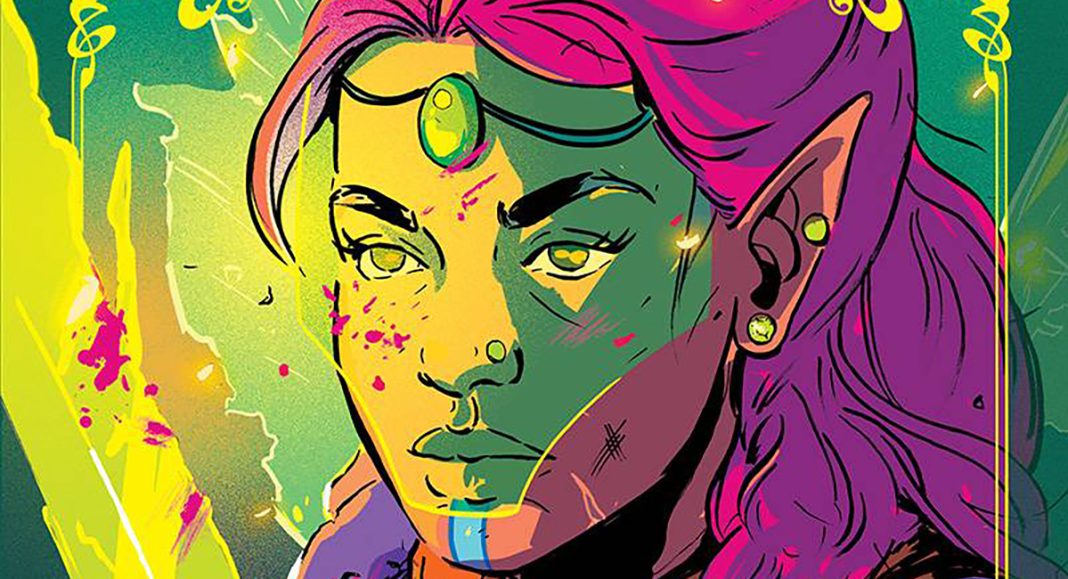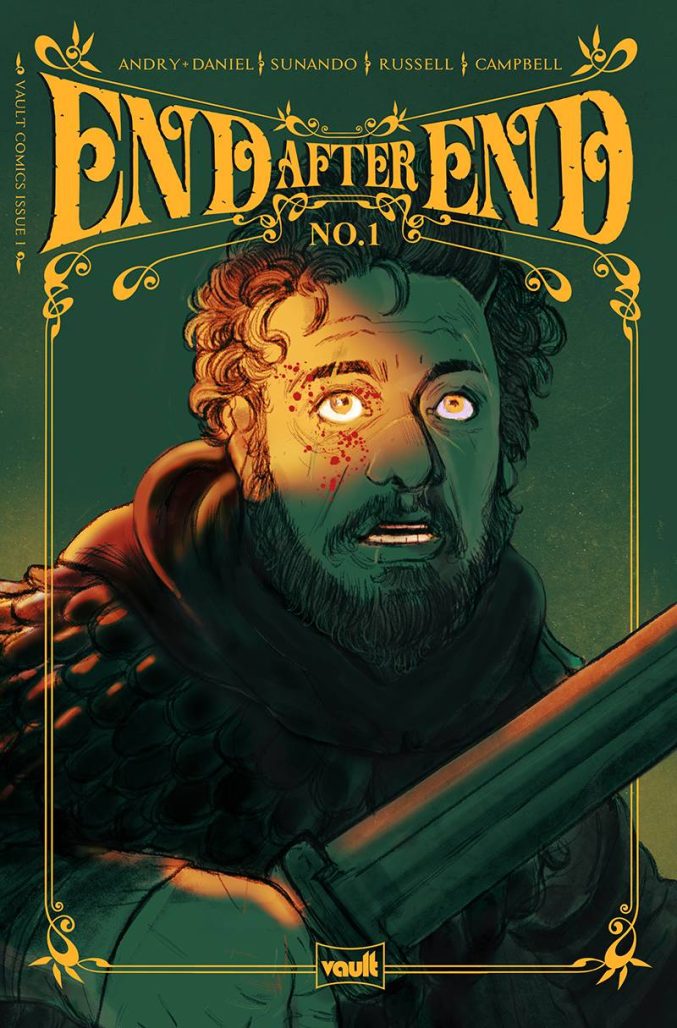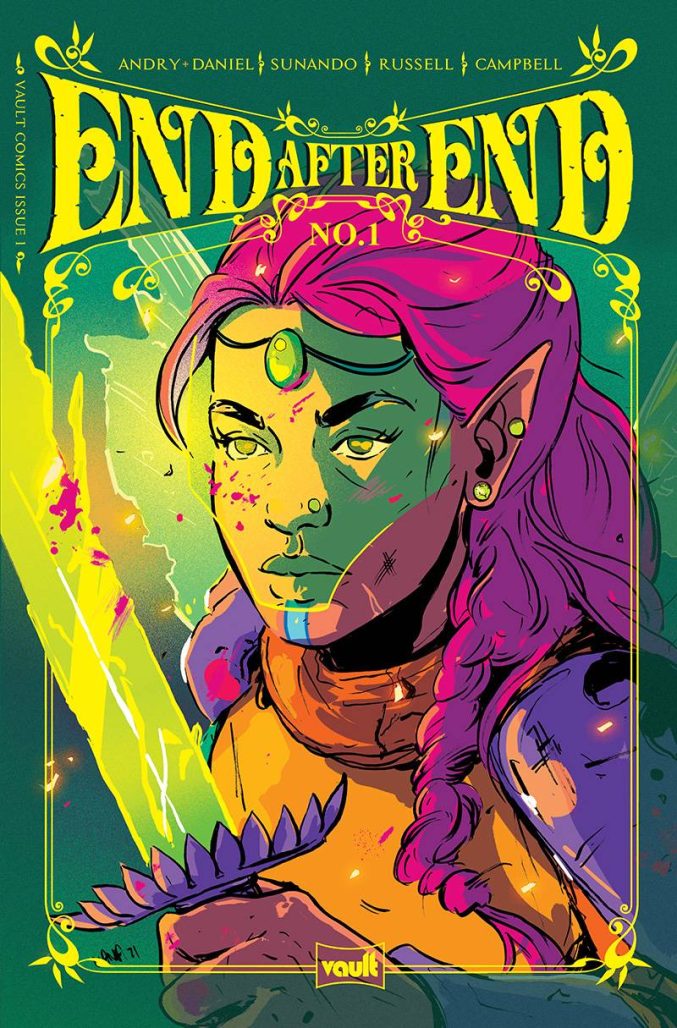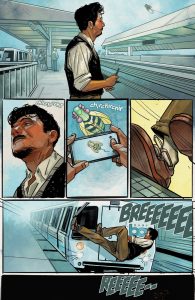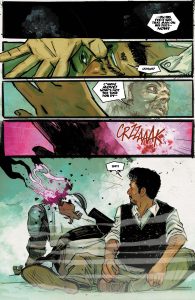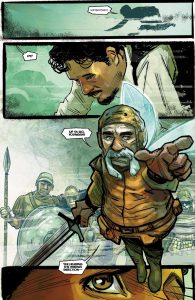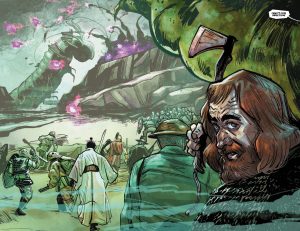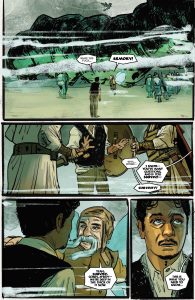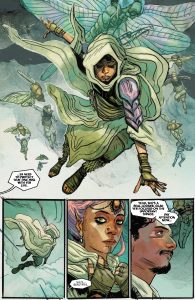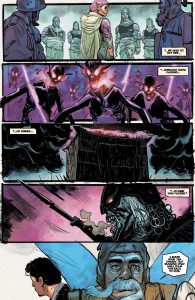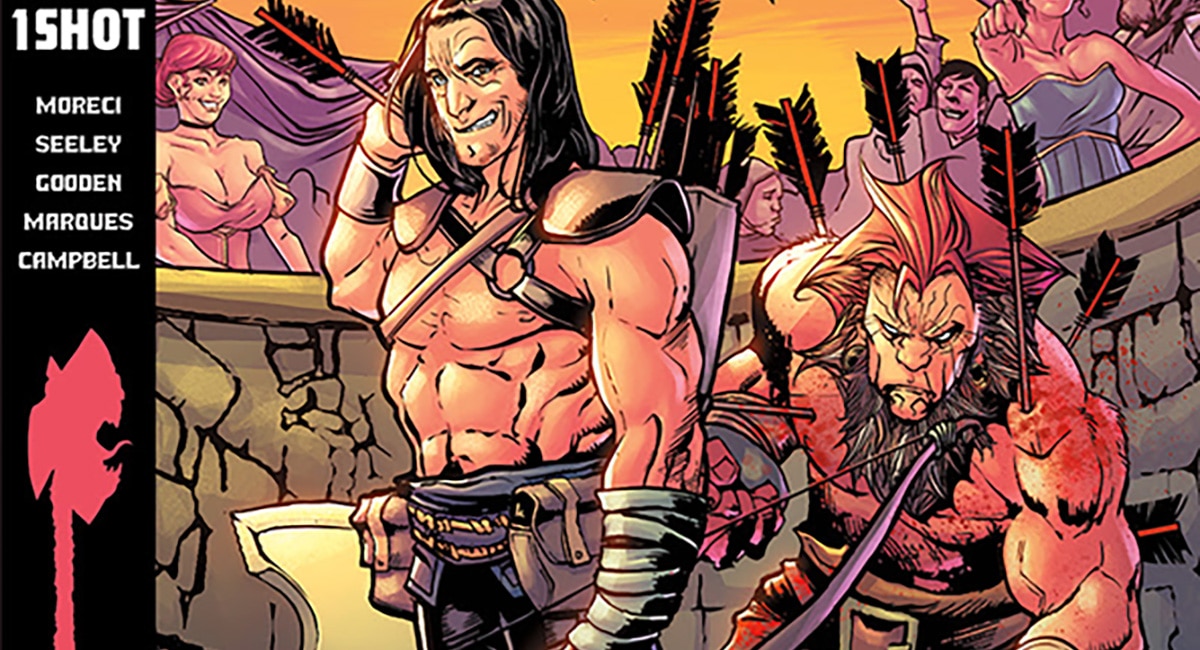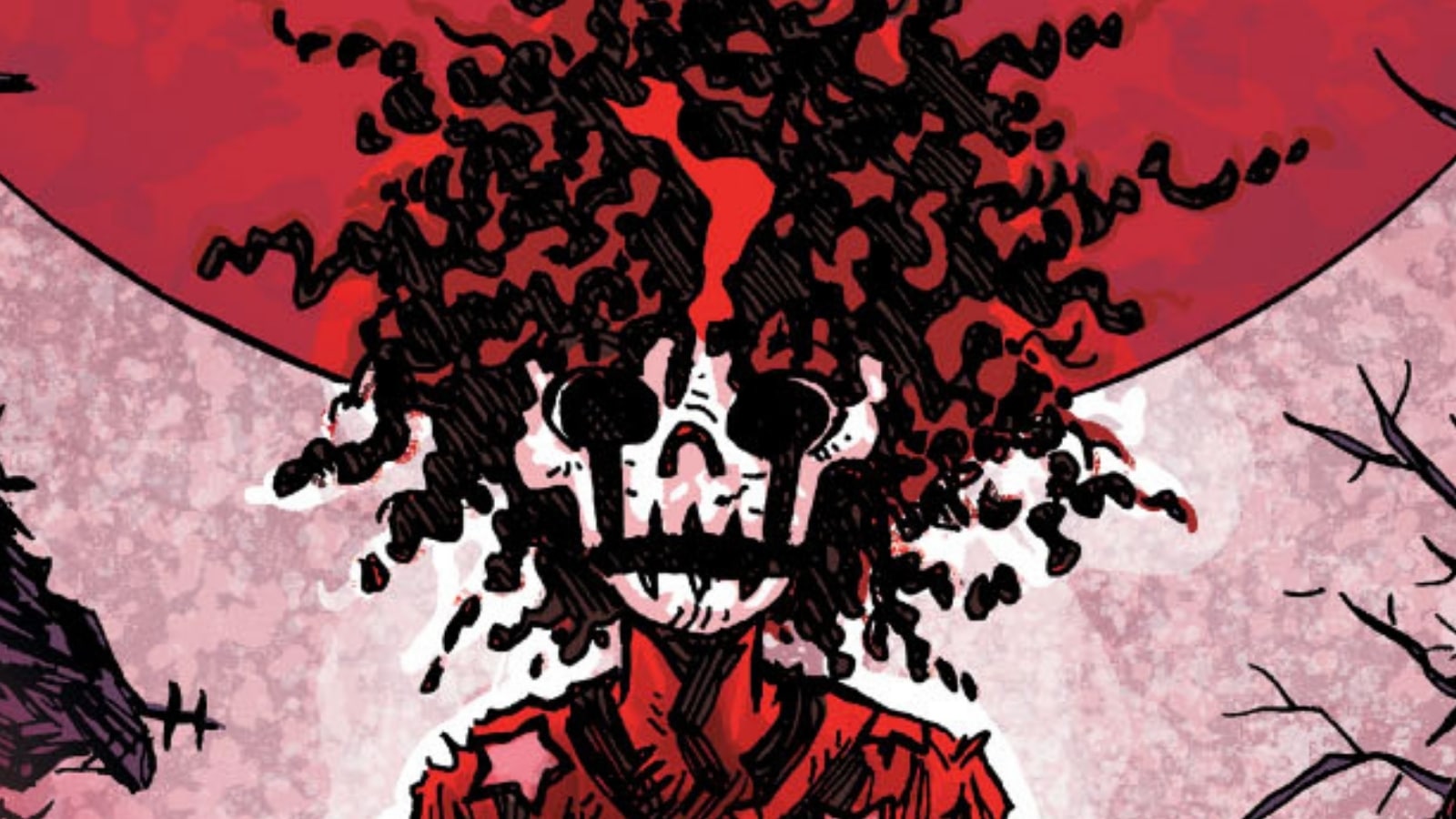There are a few different interpretations of the afterlife. Some offer an elaborate, spiritual bliss while others are much bleaker and final. In Vault’s End After End, writers Tim Daniel and David Andry provide a fresh perspective on what happens after our life is over. Sunando C is on art and covers while Kurt Michael Russell and Jim Campbell are on colors and letters respectively. Daniel also serves as designer, and fans can look for a variant cover by Liana Kangas.
Andry, Daniel, and Sunando C. chatted with The Beat to discuss the new fantasy series and their own personal concepts of the afterlife.
Deanna Destito: This is a really original, unique take on the afterlife. How did you come up with this concept?
David Andry: I think concept is the correct term to use here because a vague concept is all I had when Tim and I started talking about this project. I was playing around with the idea that your life flashes before your eyes right before you die and that morphed into what if you had a whole other life right before the end. In the microsecond before it all went black, what if that moment stretched out into another eternity and you had this whole other existence before you were gone for good. I wanted our main character to be just a regular guy, no particularly special set of skills that would prepare him for the second life and have him just tossed into this chaotic world. Bringing that to Tim, we were able to develop this basic concept into the world that is the End After End.
Tim Daniel: Thank you! We’ll take this compliment, but I’ll add that any take on the afterlife is original and unique in its own right, since who’s to really say. That right there gives us a lot of license. For my part, I was staring at my wife’s extraordinary backyard flower garden during the course of our weekly planning meetings and it is a pocket paradise. It’s her heaven on earth, a place of peace and comfort, especially over the last couple of years. Many of our creatures and some characters are named for the flora of her garden and it definitely played a huge role in inspiring the idea that the End After End was once an idyllic place despoiled by war.
Sunando C: I came into that part of the process later but I think my contributions were to clarify some of the rules of the world with DB and Tim, that anything from any point in the past, ending up to our current time could be mined. No futuristic weapons, sci-fi things, no cyborgs, etc. Another was our ‘mix and match’ rule which is that you’d see weird stylistic mash-ups for example a samurai warrior with a Viking helmet and a bazooka. If it’s a never-ending battle, you’re going to pick up and use things and adapt whatever it is you need to survive because as Grink says in the first issue, if you die in the EAE you die for good.
Destito: We’ve heard that Tim doesn’t love/didn’t want to do fantasy. How did you get him on board?
Daniel: Who’s the mole!?
Andry: When Tim came to me with the idea that we work together on something, I jumped on the opportunity. We’d been friends for over 10 years at that time and it seemed so obvious that we should work together, it was weird that we hadn’t done it yet. A couple minutes into that first conversation, I asked if he had anything in mind and he replied that he was open to anything, “Anything but fantasy” is a direct quote. Oh boy. I did go ahead and plow forward with “I’ve got this fantasy thing…” but immediately let him know I wanted it to be grounded, character-focused and definitely not your normal fantasy story. If you’ve read any of Tim’s previous work, you know that characters and relationships are always pivotal in his stories. I knew that if we could make a book that a non-fantasy fan like Tim would like, we’d have something special. So we took our main character and stuck his boots on the ground, in the mud really. We took fantasy down into the mud too, down to the footsoldier level, and we tell a character-based, propulsive story that’s always moving forward. Once we got started with these things as our touchstones, Tim was all in.
Tim, what enticed you about this fantasy series?
Daniel: Working with David was the difference maker. And when he said, “I’ve got this fantasy thing…” it threw me, I recoiled, as my career has clearly been almost exclusively sci-fi and horror. But then he very quickly added, “But wait, there’s more!” and this was 2019 when the first planning discussion took place and we had both recently seen the World War I movie 1917 which is ultra propulsive. When David said he wanted to tell the tale from the viewpoint of a foot soldier, essentially what amounted to anonymous cannon fodder, it clicked instantly–End After End is a war fantasy! We could shed the intricacies of world-building and complex rule sets of the fantasy genre and really hit the ground running at a breakneck pace. And do we ever deliver on that promise.
Destito: How is it working together as a creative team?
Andry: The team has been amazing! Everyone has taken such ownership of the project, it’s been a really special experience. With Tim and I, this has been our very first co-writing experience. I was very nervous going into the project. I’ve never co-written with anyone before and I was unsure if it was for me. But Tim and I immediately fell into a perfect rhythm. Without even discussing it, we developed an ideal system for us. We both come at writing with the same goals, to make something that means something. Sure, we’d love our comics to be popular and make a ton of sales, but we never even discuss that. It’s just us, trying to make the best comics we can, ones that say something about our world, that explore things that scare or excite us, that will make an impact on the reader. Because we’re rowing the boat the same way, everything else is easy. I mentioned to Tim on one of our many phone calls, that it feels like we are both doing the part of writing that is the easiest and most fun for us. I can’t imagine writing without him now, it’s been that good of an experience.
Sunando C: EAE has had the most collaborative process I’ve been a part of in comics so far. Everything we’re doing, step-by-step, gets shared on our Discord and then we all weigh in, give notes, it’s very much a team effort between Tim, David, Kurt, Liana, and me and I love it. I know that working with Tim and Kurt in particular has definitely made me a better artist. Kurt is, without doubt, a co-artist here, with the amount of weightlifting he does for the final look of the book. Absolute wizard. I can send him the sketchiest lines and he sends magic back. Tim has this reputation for being everyone’s ‘comics dad’ but keeping to the context of EAE, he’s been the Grink to my Walt.
Daniel: Sun’s telling it! The experience has surpassed my expectations. We recently had a chance to talk about the series in a video interview. Afterward, David and I recapped the experience on a private call. We both were so energized and arrived almost immediately and simultaneously upon the fact that we were both very proud of what this team has created.
The only real cue we offered to Sunando and Kurt Michael Russell, our colorist, was using Ralph Bakshi’s classic animated features (LOTR, Fire & Ice) as a springboard. Amazingly, they both synthesized that input and their individual styles into what is clearly a fresh new look specific to End After End. When you’re surrounded by professionals so wholly focused on the process of creation, cursed by integrity so to speak, then the result is often extraordinary, as it is with their work on the End After End.
Destito: When creating the visuals, how did you approach both the real-life elements and the fantasy portions? Did it differ from how you’d create a book that was only realistic or only fantasy?
Sunando C: I don’t think the process differed in that I read a script and try to adapt my drawing to what I think would work for the story and push myself in that direction instead of just having one fixed ‘style’ that I draw comics in. EAE has the main storyline set in the EAE and each issue has flashbacks to Walt’s life (with issue 04 being set almost entirely while Walt was alive). What I tried to do with the flashbacks is to draw them a little more ‘real’ but also a little looser, sketchier, like how your memories from childhood or high school get a little fuzzier with time except for a couple of details, a face, a moment, something especially painful or memorable that you remember in crystal clear detail.
Daniel: I’d seen Sunando’s work when designing the collection of his neo-noir series Memoria with Curt Pires, which is very gritty and rough-hewn since it is crime-geared. David wanted to “drag readers through the mud” as he put it. That was enough right there to give the fantasy element of the book a real hard edge—a powerfully grounded measure of realism. With Sunando being from Bangalore, India we also saw another opportunity and asked that he make Walter Willem his own. That not only changed Walt but the entire look of the book!
Andry: I mostly stay out of the visuals other than the descriptions in the script. When you work with artistic geniuses like Sunando, Kurt Michael Russell, Tim Daniel, and Liana Kangas, (on alternate covers for the entire series!) the best thing I can do is stay out of the way! I’ll make the very occasional suggestion, but this team is all rockstars so I want to let them do what they do.
Destito: For fans who may not choose this genre immediately, what would you say is a reason to dive into this world?
Sunando C: Like Tim, I wasn’t much of a fantasy guy coming into this project but I think having two of three co-creators who approached this series from that POV helped make it more accessible. Actually, I’d go so far as saying EAE is a fantasy book isn’t entirely accurate in that we’ve used the world of EAE as a setting for a number of done-in-one genres. Issue 01 is our big, explosive war story, issue 02 is a smaller, eerier, cave horror story, issue 03 is a big action-adventure train heist, and so on.
Daniel: Well said Sunando, that’s a keen observation. You just sold me the book! Pre-ordered! I’ll add that End After End offers readers a very strong thematic exploration of heroism—not necessarily via any grand and magnificent act, but how the smallest measures can make the biggest impact. For those aspiring creatives that make the entire 10-issue journey with us, Walt’s arc is an unflinching look at what it means to make an artistic mark, the struggle, challenges, and obstacles. Determining your value as an artist, and learning to appreciate your art and how both can be clouded by doubt and ultimately overcome through self-acceptance.
Andry: As the lone fantasy fan here, I’ll say that we definitely made End After End accessible for everyone, but fantasy fans will find plenty to love here. There are magic relics, a quest, monsters, and fae creatures. People who enjoyed Lord of the Rings and Willow will be on familiar ground with our book.
Destito: If you had an epic afterlife, what would you want it to be?
Sunando C: I had to think about this but if there IS an actual post-life farm where all the pets end up I’d like to go there too.
Daniel: Naturally, I’d hope to find myself in the garden with my wife and afterward on a story planning call with David.
Andry: The End After End would be a rough one to end up in, I don’t think I’d last as long as Walt does. But I’d like to go somewhere like that, where you get to restart, try to do better a second time.
Look for End After End on August 24. Check out some preview pages below!


